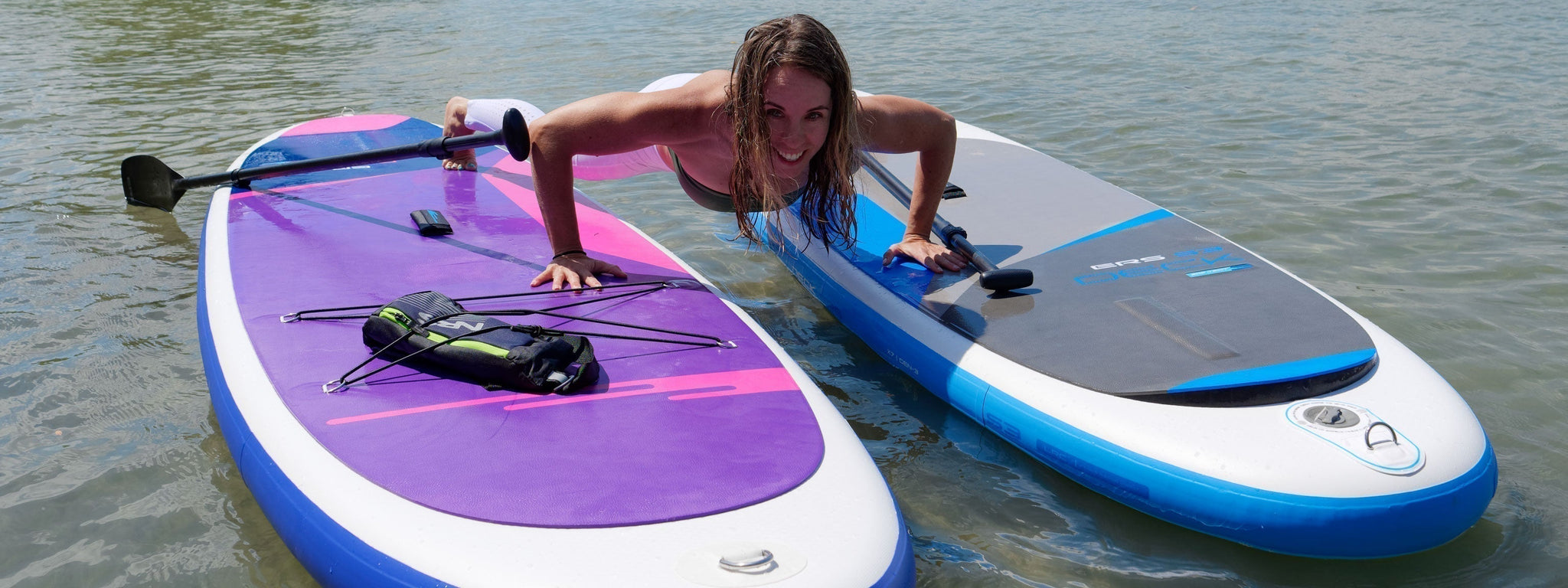
How To Choose An Ultra-Stable Inflatable SUP
There is little doubt that an ultra-stable paddleboard is the best type of board for beginners to get started on so they can learn the basics of paddling with the odds for success stacked in their favor.
A board with enough stability can get most first-timers standing up and paddling in minutes and well on their way to mastering the basic strokes and skills by the end of their first SUP lesson.

Stability Paddle Boards Are Not Just For Beginners
While you might think that stability boards are mainly for beginners, there are actually a number of reasons why you might want to own a SUP board designed for stability.
You may be heavier than average or lacking confidence in your balance.
You may want to be able to handle choppy waters or boat wake while staying dry and avoiding unwanted swims.
Or maybe you are planning to use your board for yoga or fishing or to take your child or pet on board. You may even have thoughts of hitting some whitewater and running rapids, which will require more stability than a typical all around board.

What Makes One SUP Board More Stable Than Others?
It is accepted that the core stability of a board is a function of its width, but this tells only part of the story. While it is true that a wider board will generally be more stable than a narrower board if all other factors are equal, there are other factors that come together to make a stable SUP board that also performs well and is fun to paddle.
The main factors that need to be considered along with board width, are board thickness and outline shape.
Board thickness is the design factor most overlooked by board manufacturers and shoppers, and it has a huge impact on board stability – and is often the opposite of conventional wisdom.
In the early days of inflatable paddle board design, all boards were about 4 inches thick. At that thickness, rigidity and volume were inadequate for many riders. 4 inch thick boards had a tendency to flex excessively and even buckle in the middle with heavier riders.
To solve this problem, materials were introduced to produce boards of 6-inch thickness, which were much more rigid than 4-inch boards and had more volume to support heavier riders. The industry moved to 6-inch boards en masse based on the notion that thicker is always better.
The problem with making a board thicker than it needs to be is that the 2 inches of thickness added to the existing 4-inch board design raises the center of gravity of the board, which actually decreases stability and make a board feel more wobbly.
6-inch board thickness makes sense for certain board types for which the extra thickness is necessary to enhance the performance characteristics of the board, and we have no problem seeing it when it makes sense to the overall shape, design, and purpose of the board.
For many all around boards, 6 inches is too much – and 5 inches provides the right balance of stability, rigidity, volume, and board feel.

Unsure about how much stability you need on a new SUP purchase? Work with us and to find an individual solution that gives you the ultimate confidence out on the water.
There are other factors that affect the stability of a board beyond width and thickness. For example, a board that is wider at the tail will feel more stable during paddling maneuvers because most of your footwork will occur toward the rear of the board.
A board that is wider at the nose will be more stable when a passenger or dog is on board. Overall, boards with a less aggressive sidecut will be more stable than more angular boards that are very narrow at the nose or tail.

Fin Set Up
Fins contribute to the stability of the board by providing some resistance to tipping, although the width, thickness, and outline of the board have much more impact on the stability of a SUP board.
The fin system of a board is more of a factor in how the board will perform and what water environments it will thrive in.
Boards in the lower price ranges often share a common fin setup that has a removable center fin that is specific to the board manufacturer and a pair of small permanently affixed side bite fins. There are some drawbacks to this arrangement.
Firstly, the center fin can be difficult to replace if it is lost or damaged since it can only be supplied by the board manufacturer. If you need to use the board without the center fin, the small side fins are unlikely to give you enough traction to paddle efficiently without the board spinning uncontrollably. Also, the center fins on lower cost boards usually lack the ability to move forward or backward in the fin box to affect the board performance.
A simple fin system that works well for many paddlers is a set of three permanently affixed flexible unbreakable fins. The fins will usually be of equal size so there is no longer center fin that can bottom out in shallow water.
Permanent fins can also make the board more carefree to use since you don’t need to worry about losing or forgetting to pack a fin, breaking fins in use or during board handling, or having to decide which fins to attach before setting out on a paddle.
For maximum flexibility in using the board, you can opt for a configurable fin system consisting of three fin boxes that accept various swappable fins. The most advanced of these systems will have a US standard fin box for the center fin and FCS compatible boxes for the side fins.
The US fin box will accept a variety of fins from different manufacturers and allows you to move the fin forward and towards the back of the fin box to change how easily your board tracks or turns. Side fin boxes should accept fins ranging from 2 inches to 5 inches in height that are available from different manufacturers and therefore easily replaceable.
Having a configurable fin system gives you many options for fin setup. For general paddling, you can use a long center fin and optionally two shorter side fins.
When speed is a priority, you can use a long center fin alone, which has the least drag of any fin setup. For paddling in shallow waters, you can use a short center fin with short side fins to give you the traction you need without a long fin that might bottom out.
If you progress to more technical paddling in surf or whitewater, you can tune your board’s performance with fins of different lengths, shapes, and flex patterns.

Deck Pads Can Enhance Various Board Uses
The deck pad won’t directly affect the stability of the board but does impact how well it will be suited to the various paddling activities you can do on a stability board. For flat water, fitness paddling, and yoga, a relatively smooth deck pad with a shallow croc skin or brushed surface will give you plenty of traction and feel comfortable on your feet.
For whitewater, surfing, and other turbulent water environments, a more deeply grooved diamond or square groove pattern will enhance foot grip and help shed water off the board surface.
A longer deck pad that covers up to 75% of the board length is ideal if you have thoughts of doing SUP Yoga or paddling with a dog on board.
Many boards have a bulky, permanently affixed handle, but a board with a flat strap handle and a removable neoprene hand grip will reduce hand fatigue while carrying the boards and allow you to flatten the handle for yoga or more intense paddling situations where you don’t want a bulky handle getting in the way of your footwork.

Inflatable vs. Hard Board For Stability
An inflatable paddle board, inflated to its recommended pressure, will typically be more stable than a hard board of the same dimensions. This is because the thickness of an inflatable board is consistent across the width and length of the board, so there is more buoyancy overall, and particularly at the edges, nose, and tail, where hardboards tend to thin out.

Choosing A Board For Stability Doesn’t Mean Sacrificing Performance
While a stability board can make learning easier and keep you afloat with increased confidence, it can also be a lot of fun to paddle and can let you do things that wouldn’t otherwise be possible on a smaller board. Whitewater, yoga, fishing, paddling with your pup, taking the kids out for a paddle, are all things that are easier to do on a board with ample stability.
When choosing a board for stability, be sure to consider the difference that board thickness will make and make sure the deck pad and fin system will allow you to do all of the activities that are possible on an ultra-stable SUP board.
See our top ultra stable inflatable paddle board picks here.

Want Expert Advice on Choosing an Inflatable SUP Board?
Check out our 2025 Inflatable Paddle Board Buying Guide - or - The Best Inflatable Paddle Board - Reality vs the Internet.
Want To Buy an Inflatable SUP Board?
Explore our range of SUP boards for sale by activity / use in Inflatable SUP Type or focus on Inflatable SUP Brands to find the right board for you.
Want Answers to Anything Stand Up Paddle Boarding and Inflatable SUP?
The Pumped Up SUP SUP Paddle Blog is the best resource on the internet for up to date information to help with your next inflatable SUP purchase!




